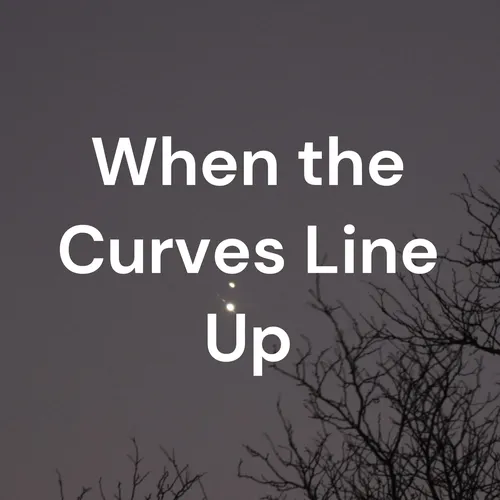
When the Curves Line Up
Watching the Sun, Moon and Planets
- Update frequency
- every day
- Average duration
- 4 minutes
- Episodes
- 1419
- Years Active
- 2021 - 2025

2023, January 13: Virgo Moon, Venus Approaches Saturn
January 13, 2023: The morning gibbous moon is in front of Virgo. After sunset, Venus closes in on Saturn, leading up to the January 22nd conjunction. Jupiter and Mars are visible as well.
This epis…

2023, January 12: Mars’ Retrograde Ends, Western Planets in Line
January 12, 2023: Mars resumes its eastward march in Taurus tonight. With Mars in the east, Venus, Saturn, and Jupiter are in a line in the western sky.
This episode is also available as a blog post…

2023, January 11: Lion Moon, Evening Planet Dance
January 11, 2023: Before sunrise, the gibbous moon seems to appear in the belly of the Lion. During the early evening hours, the four bright planets continue their dance.
This episode is also availa…

2023, January 10: Handled Moon, Bright Evening Planets
January 10, 2023: The morning moon appears near the Sickle of Leo. After sunset, the four bright planets are visible from the southwest to the east.
This episode is also available as a blog post: 20…

2023, January 9: Morning Moon, Venus Takes Aim
January 9, 2023: The bright gibbous moon is in the west before sunrise. After sunset, Venus moves closer to Saturn. Jupiter and Mars are visible as well. Sky watchers with telescopes have a double…

2023, January 8: Bright Morning Moon, Evening Planet Quartet
January 8, 2023: The bright moon is in the west before sunrise. Venus, Saturn, Jupiter, and Mars are along an arc from east to southwest after sundown.
This episode is also available as a blog post:…

2023, January 7: Mercury, Inferior Conjunction, Evening Planet Display Continues
January 7, 2023: Mercury is at inferior conjunction between Earth and the sun. Venus, Saturn, Jupiter, and Mars continue with their evening display after sundown.
This episode is also available as a…

2023, January 6: Wolf Moon, Evening, Four Bright Planets
January 6, 2023: The bright Full moon appears near Castor and Pollux all night. Four bright planets – Venus, Saturn, Jupiter, and Mars – span the sky after sundown.
This episode is also available as…

2023, January 5: Bright Moon, Evening Planets, Orion’s Rigel
January 5, 2023: The bright moon can be seen before sunrise and after sunset. Four bright planets are strung across the sky from southwest to east after sundown. Orion’s Rigel rises at sundown.
Thi…

2023, January 4: Earth at Perihelion, Gored Moon
January 4, 2023: Earth is at perihelion today and closest to the sun. The evening moon is caught between the Bull’s Horns. Four planets shine brightly after sundown.
This episode is also available …

2023, January 3: The Summer Triangle Morning, Evening Planets, Moon
January 3, 2023: The Summer Triangle is visible before sunrise and after sunset. Four planets are strung across the sky after sundown. The gibbous moon is near Mars.
This episode is also available …

2023, January 2: Morning’s Western Stars, Evening Planets, Moon
January 2, 2023: Bright winter stars are in the western sky before sunrise. After sundown, four planets, Venus, Saturn, Jupiter, and Mars, along with the moon are visible.
This episode is also avai…

2023, January 1: Morning Scorpion, Four Bright Evening Planets, Moon
January 1, 2023: The Scorpion crawls into the southeastern sky before sunrise. After sunset, four bright planets and gibbous moon are along an arc across the sky.
This episode is also available as …

2022, December 31: Goodbye, Mercury, Morning Galaxies, Evening Planets
December 31, 2022: Mercury begins to depart the evening sky, leaving four bright planets – Venus, Saturn, Jupiter, and Mars on display for New Year’s Eve.
This episode is also available as a blog pos…

2022, December 30: Sirius Highest at Midnight, Evening Planets, Moon
December 30, 2022: The night’s brightest star, Sirius, is in the south at midnight as the year ends. The bright planet evening display continues as Mercury disappears into bright twilight.
This epis…

2022, December 29: Evening Planets, Mercury Retrogrades
December 29, 2022: The evening planet display is ending as Mercury begins to retrograde and fade in brightness. Look for Venus, Mercury, Jupiter, Moon, and Mars after sundown.
This episode is also av…

2022, December 28: Bright Planet Display Finale
December 28, 2022: Not until 2028 are the five bright planets visible again. Venus, Mercury, Saturn, Jupiter, and Mars are strung across the evening sky. The opportunity to see them is quickly endi…

2022, December 27: Crescent Moon, Rare Five-Planet Exhibition
December 27, 2022: The crescent moon appears with the five bright planets – Venus, Mercury, Saturn, Jupiter, and Mars – after sundown.
This episode is also available as a blog post: 2022, December 2…

2022, December 26: Moon Points to Saturn in Evening Planet Display, Mars-Aldebaran Conjunction
December 26, 2022: The five bright planet display continues after sunset. The moon is near Saturn. Mars passes Aldebaran.
This episode is also available as a blog post: 2022, December 26: Moon Poi…

2022, December 25: Christmas Five Planet Display
December 25, 2022: The five bright planets – Mercury, Venus, Mars, Jupiter, and Saturn – put on a Christmas Evening display after sunset.
This episode is also available as a blog post: 2022, Decembe…